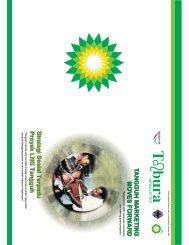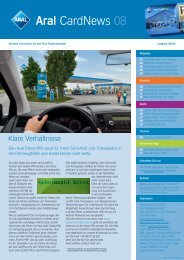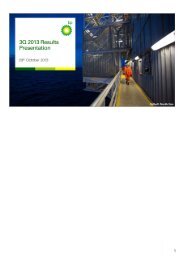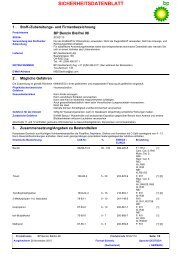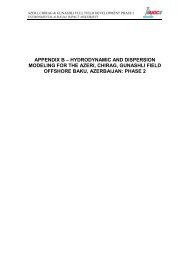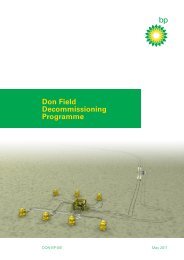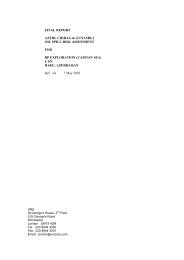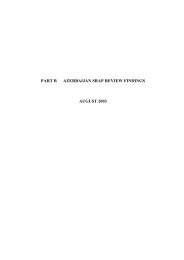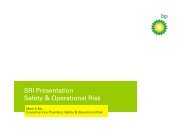HSE DIRECTIVE 11 SAFE JOB ANALYSIS - BP
HSE DIRECTIVE 11 SAFE JOB ANALYSIS - BP
HSE DIRECTIVE 11 SAFE JOB ANALYSIS - BP
Create successful ePaper yourself
Turn your PDF publications into a flip-book with our unique Google optimized e-Paper software.
<strong>HSE</strong> <strong>DIRECTIVE</strong> <strong>11</strong><br />
<strong>SAFE</strong> <strong>JOB</strong> <strong>ANALYSIS</strong><br />
Directive owner per 01.01.2013 Bjarte Skulstad<br />
Please consult the asset’s <strong>HSE</strong> instructions for potential<br />
installation specific requirements
1 GENERAL<br />
Purpose<br />
The purpose of the directive is to ensure that<br />
• a Safe Job Analysis is used when planning critical work tasks<br />
• a Safe Job Analysis is carried out in a systematic manner<br />
and in accordance with standard practice on the Norwegian<br />
continental shelf<br />
Domain<br />
The directive applies to all <strong>BP</strong>-operated and contracted installations<br />
on the Norwegian continental shelf<br />
Onshore facilities or projects where <strong>BP</strong> Norge have a particular<br />
responsibility and which are assessed being part of the petroleum<br />
activities. Contractors of contracted installations who have<br />
a system that satisfies the requirements in this directive, may<br />
use their own system provided this has been clarified upon<br />
implementation<br />
References<br />
• Activities regulations § 30<br />
• OMS Risk 3.1 Risk Assessment and Management<br />
• Norwegian Oil and Gas Association guideline 090 Common<br />
Model for Safe Job Analysis<br />
• <strong>HSE</strong> Directive no. 1 - Work Permits<br />
Definitions and abbreviations<br />
• A Work Permit (WP) is a written permission to carry out<br />
a defined job at a specific place on an installation in a safe<br />
manner and under certain conditions<br />
• The Department Manager is the manager of a specific<br />
department<br />
• CCR (Central Control Room)<br />
• <strong>HSE</strong> function (safety officer) - <strong>HSE</strong> advisor<br />
• The Area Authority is head of all activities within a certain<br />
area<br />
• The Area Technician has the operational responsibility for a<br />
specific system or area<br />
• The Offshore Installation Manager (OIM) is the top<br />
manager of all activities in the field<br />
• A Safe Job Analysis(SJA) is a systematic and step-bystep<br />
review of all elements of risk carried out prior to a<br />
specific task or operatoin so that measures can be taken to<br />
remove or control any elements of risk identified during the<br />
preparation for or performance of the said task or operation.<br />
• The person responsible for the SJA is the person<br />
responsible for the SJA, e.g. the supervisor, area authority<br />
or anyone else given the responsibility for the work to be<br />
performed.<br />
• A CCR Technician is a person in the central control room<br />
who controls and coordinates all production and other work<br />
on board.<br />
307
308<br />
2 RESPONSIBILITY<br />
Offshore Installation Manager (OIM)<br />
is responsible for<br />
• ensuring that a Safe Job Analysis (SJA) is carried out for<br />
critical operations as described in the directive<br />
• ensuring that SJAs are performed in accordance with the<br />
directive and guidelines<br />
• ensuring that all relevant personnel have the knowledge<br />
necessary to prepare a SJA, in line with their roles in<br />
connection with the performance of SJAs<br />
Person responsible for the SJA<br />
is responsible for<br />
• preparing and inviting to the SJA meeting<br />
• chairing the SJA meeting<br />
• ensuring that analyses with participants are documented<br />
• ensuring that all identified measures are implemented<br />
• ensuring that experiences are summed up on completion<br />
of the work<br />
Person responsible for performing the work (Supervisor)<br />
is responsible for<br />
• performing the work concerned<br />
• ensuring that conditions and measures identified in the SJA<br />
are satisfied and implemented<br />
Person responsible for measures<br />
is responsible for carrying out measures identified in the SJA<br />
Department Manager<br />
is responsible for<br />
• filing all completed SJAs in his/her department<br />
Area Authority<br />
is responsible for<br />
• approving the SJA<br />
Offshore Installation Manager (OIM)<br />
is responsible for<br />
• ensuring that a Safe Job Analysis (SJA) is carried out for<br />
critical operations as described in the directive<br />
• ensuring that SJAs are performed in accordance with the<br />
directive and guidelines<br />
• ensuring that all relevant personnel have the knowledge<br />
necessary to prepare a SJA, in line with their roles in<br />
connection with the performance of SJAs
3 USE OF <strong>SAFE</strong> <strong>JOB</strong>ANALYSES<br />
Identifying the need for a SJA<br />
• A Safe Job Analysis (SJA) shall be carried out for a work task<br />
when<br />
o risk elements exist or may occur, and these are not<br />
sufficiently considered and examined in procedures or<br />
work permits<br />
o there is a requirement for this in procedures, directives or<br />
work programmes<br />
o The following must be taken into account when<br />
considering the need for a SJA :<br />
1. Is the work task described in procedures/routines or does it<br />
require deviations from these?<br />
2. Have all the elements of risk been considered and examined<br />
through the work permit?<br />
3. Do undesired incidents often occur in this type of work?<br />
4. Is the work risky, complex or does it involve more than one<br />
discipline group?<br />
5. Is new equipment or methods not covered by procedures or<br />
methods used?<br />
6. Do the personnel performing the job have experience in the<br />
work concerned?<br />
Responsibility for identifying the need for a SJA<br />
• Everyone involved in planning, approving and performing<br />
work and work permits shall consider whether a SJA is<br />
required<br />
• A new SJA shall be carried out for each job. It may<br />
nevertheless be sensible to use lessons learnt from<br />
previously performed SJAs<br />
• When the need for a SJA has been demonstrated, a person<br />
responsible for the SJA shall be appointed<br />
4 PERFORMING SJA`S<br />
Preparation<br />
• In preparation for an SJA meeting, the person responsible<br />
for the SJA shall<br />
• collect data, drawings, previous experience and any available<br />
risk assessments for the work in question<br />
• prepare draft breakdown of the work into sub-tasks and<br />
showing sequence of the work execution<br />
• consider preconditions for the work<br />
• define participants to carry out the SJA (the SJA group)<br />
• call an SJA meeting<br />
• The SJA meeting must be carried out as near in time as<br />
practically possible to the start-up of the work<br />
309
310<br />
Participants in the SJA group<br />
Everyone actively involved in the preparations for and performance<br />
of the job concerned will normally be part of the SJA<br />
group, and may include:<br />
• The person responsible for the SJA<br />
• The supervisor<br />
• The area authority<br />
• The area technician<br />
• The performing personnel<br />
• The relevant safety delegate (shall always be invited)<br />
• Personnel with relevant discipline skills for the analysis<br />
• Personnel affected by the work<br />
• <strong>HSE</strong> function<br />
Performing a SJA<br />
The SJA Form shall be used for implementation.<br />
The Guidelines for using and filling in SJA forms can be used.<br />
1. The person responsible for the SJA reviews the job to be<br />
done, with preconditions and necessary basis for planning<br />
2. The SJA group shall carry out an inspection of the work site<br />
3. The SJA group breaks down the entire job into sub-tasks,<br />
which are described briefly, clearly and action-oriented<br />
4. The SJA group identifies potential hazard elements for personnel,<br />
the environment or financial values for each sub-task<br />
5. The SJA group considers the probability of hazard elements,<br />
and consequences in the event that hazards arise, on the<br />
basis of their experience and best judgement. A risk matrix<br />
can be used to facilitate this process<br />
6. The SJA group identifies primarily measures that can<br />
prevent hazardous incidents from occurring (probability-reducing<br />
measures). The SJA checklist is to be used to<br />
quality-assure that potential hazard elements, consequences<br />
and measures are assessed.<br />
7. The person responsible for the SJA identifies persons<br />
responsible for the identified measures, and notes this<br />
information on the form.<br />
8. The SJA group evaluates remaining risk and conducts a<br />
comprehensive evaluation to determine whether the work<br />
can be / cannot be implemented.<br />
Documentation<br />
• The Safe Job Analysis must be documented in the SJA<br />
form which will be signed by the person responsible for the<br />
SJA on behalf of the SJA group.<br />
• The SJA checklist and signed List of Participants must be<br />
attached to the SJA form
Approval<br />
• The area authority and supervisor review and approve the<br />
SJA form<br />
• The daily information meeting will be informed of, and<br />
coordinate the planned SJA job<br />
Performing a job<br />
• All personnel involved will go through the job immediately<br />
before starting to work. The job must be performed in<br />
accordance with the SJA and the work permit<br />
• Prior to and during the work being performed, the supervisor<br />
shall ensure that<br />
o the preconditions for the work are fulfilled<br />
o all planned measures have been taken<br />
The work must be stopped forthwith in the event of changes in<br />
the preconditions or measures described in the SJA and may<br />
not be resumed until a new SJA has been carried out.<br />
• The supervisor must make sure that any new performing<br />
personnel go through the SJA documentation thoroughly<br />
before starting to work. This must be documented and<br />
signed for on the List of Participants<br />
Experience transfer<br />
• On completion of the work the person responsible for the<br />
SJA will prepare a brief summary of the SJA-related lessons<br />
learnt from the work. The summary will be registered in the<br />
SJA form<br />
• The department manager will file the SJA form w/<br />
appendices and the lessons learnt for his/her department.<br />
The SJA must be numbered so as to be easily retrievable.<br />
3<strong>11</strong>
<strong>HSE</strong> <strong>DIRECTIVE</strong> <strong>11</strong><br />
<strong>SAFE</strong> <strong>JOB</strong> <strong>ANALYSIS</strong> ATTACHMENTS<br />
Attachment 1:<br />
SJA - Form<br />
Attachment 2:<br />
Instructions for Completion and Use Of SJA forms<br />
<strong>HSE</strong> <strong>DIRECTIVE</strong> 1 - WORK PERMITS<br />
Attachment 3: ATTACHMENTS<br />
Checklist for SJA<br />
Attachment 4: Attachment 1:<br />
SJA participant Work listPermit<br />
Form Level 1<br />
Attachment 5: Attachment 2:<br />
Risk Matrix<br />
Work Permit Form Level 2<br />
Attachment 3:<br />
Guidelines For Completing And Using Work Permit Form<br />
Attachment 4:<br />
Fire Guard´s Duties<br />
Attachment 5:<br />
Safety Measures For Working With Hydrocarbon Carrying<br />
Systems<br />
Attachment 6:<br />
Safety Measures For Working With Hazardous Chemicals<br />
Attachment 7:<br />
Safety Measures For Jet Water Washing Over 250 Bar<br />
Attachment 8:<br />
Safety Measures For Pressure Testing<br />
Attachment 9:<br />
Form For Approval Of Hot Work Class A In Classified Areas<br />
Attachment 10:<br />
Advance Approval Of Hot Work Class A In Classified Areas<br />
Attachment <strong>11</strong>:<br />
Form For Logging Heating Value
<strong>HSE</strong> <strong>DIRECTIVE</strong> 1 - WORK PERMITS<br />
ATTACHMENTS<br />
Attachment 1:<br />
Work Permit Form Level 1<br />
Attachment 2:<br />
Work Permit Form Level 2<br />
Attachment 3:<br />
Guidelines For Completing And Using Work Permit Form<br />
Attachment 4:<br />
Fire Guard´s Duties<br />
Attachment 5:<br />
Safety Measures For Working With Hydrocarbon Carrying<br />
Systems<br />
Attachment 6:<br />
Safety Measures For Working With Hazardous Chemicals<br />
Attachment 7:<br />
Safety Measures For Jet Water Washing Over 250 Bar<br />
Attachment 8:<br />
Safety Measures For Pressure Testing<br />
Attachment 9:<br />
Form For Approval Of Hot Work Class A In Classified Areas<br />
Attachment 10:<br />
Advance Approval Of Hot Work Class A In Classified Areas<br />
Attachment <strong>11</strong>:<br />
Form For Logging Heating Value
ATTACHMENT 1: SJA-FORM<br />
SJA No.: Department/Discipline: Person responsible for<br />
SJA:<br />
Installation:<br />
Tag/line no.:<br />
SJA title:<br />
Description of the work:<br />
Area/Module/Deck:<br />
WP/WO no.: Number of attachments:<br />
Requirements/Preconditions:<br />
No Basic steps Hazard/cause Potential consequence Measures Person responsible for<br />
measures<br />
Approval Date/Signature Checklist for SJA applied –tick off<br />
Person responsible for SJA (Recom.)<br />
Summary of experience after completion of the work:<br />
Responsible for execution<br />
(Recom.)<br />
Area/Operations supervisor (Appro.)<br />
Other position<br />
(Appro.)<br />
Is the total risk acceptable: (Yes/No)?<br />
Conclusion/comments:<br />
315
316<br />
ATTACHMENT 2: INSTRUCTIONS FOR<br />
COMPLETION AND USE OF SJA FORMS<br />
Top section – to be completed by the person responsible for the<br />
SJA in preparation for the SJA meeting.<br />
SJA Tittel Brief descriptive work title<br />
SJA no. Serial number for the SJA based on the<br />
following system: SJA-U-04-01 where U<br />
stands for Ula and 04-01 is the first analysis<br />
in 2004<br />
Dept./discipline Name of the performing department/discipline<br />
SJA officer Name of the person responsible for the SJA<br />
Description of<br />
work<br />
Brief and precise description of the work<br />
Installation Name of the platform on which the work will<br />
be carried out<br />
Area/module/<br />
deck<br />
No. equipment/<br />
line<br />
Name of the area, module or deck on which<br />
the area is to be carried out<br />
The number of the equipment or pipeline on<br />
which work is to be carried out<br />
Prerequisites State any job prerequisites<br />
WP/ WO no. Reference to the work permit/work order<br />
number<br />
No. of<br />
appendices<br />
State the number of appendices<br />
In addition, the SJA officer should do a preliminary break down of<br />
the work into sub-tasks, see the mid-section of the form.<br />
Mid section – to be completed during the SJA meeting<br />
No Subtask’s serial number<br />
Subtask A brief description of each subtask, step by step<br />
• Break down the job into logical steps<br />
• Give a brief and precise description of what<br />
needs to be done at each step(not how)<br />
• Describe the subtasks in normal<br />
consecutive order<br />
• For each step, start with an action word<br />
such as “Open”, “Remove”, “Move”<br />
• Avoid too detailed/extensive descriptions of<br />
each step
Elements of<br />
risk/cause<br />
Possible<br />
consequence<br />
List all elements of risk and causes of possible<br />
undesired incidents that may occur<br />
List possible consequences of each risk/cause<br />
Measures List measures to be taken for each<br />
consequence where this is considered<br />
necessary<br />
Responsible<br />
person<br />
State the person responsible for each of the<br />
measures<br />
Signature The signature of the person responsible for<br />
carrying out the measure<br />
Lower section – to be completed at the end of the SJA meeting<br />
Checklist<br />
studied<br />
(yes/no)<br />
Is the total risk<br />
level<br />
acceptable (yes/<br />
no)<br />
Conclusion/<br />
comments<br />
State whether the SJA checklist has been<br />
used (yes or no)<br />
Indicate the team’s conclusion (yes or no)<br />
Briefly describe the conclusion of the analysis<br />
made<br />
SJA responsible SJA responsible´s signature on behalf of the<br />
SJA team<br />
Responsible<br />
for the job<br />
performance<br />
Area/operating<br />
authority<br />
Other position (not in use)<br />
Supervisor/performing technician’s approval<br />
signature<br />
Area authority’s approval signature<br />
Lower, right part To be filled in by SJA responsible after the<br />
work is completed<br />
Experience<br />
summary after<br />
the job<br />
Short description of the work according to the<br />
SJA and incidents/ situations during the work.<br />
317
318<br />
ATTACHMENT 3: CHEKCLIST FOR SJA<br />
No Checklist for SJA No:<br />
SJA Title:<br />
A Documentation and experience<br />
1 Is this a familiar work operation for the crew?<br />
2 Is there an adequate procedure/instruction/work package?<br />
3 Is the group aware of experiences/ incidents from similar activities/SJA?<br />
B Competence<br />
1 Do we have the necessary personnel and skills for the job?<br />
2 Are there other parties that should participate in the SJA meeting?<br />
C Communication and coordination<br />
1 Is this a job where several units/crews must be coordinated?<br />
2 Is good communications and suitable means of communication in place?<br />
3 Are there potential conflicts with simultaneous activities (system/area/<br />
installation)?<br />
4 Has it been made clear who is in charge for the work?<br />
5 Has sufficient time been allowed for the planning of the activities?<br />
6 Has the team considered handling of alarm/emergency situations and<br />
informed emergency functions about possible measures/actions?<br />
D Key physical safety systems<br />
1 Are barriers, to reduce the likelihood of unwanted release/leakage<br />
maintained intact (safety valve, pipe, vessel, control system etc.)?<br />
2 Are barriers, to reduce the likelihood of the ignition of a HC leakage<br />
maintained intact (detection, overpressure protection, isolation of ignition<br />
sources etc.)?<br />
3 Are barriers to isolate leakage sources/lead hydrocarbons to safe location<br />
maintained intact (process/emergency shutdown system, blowdown system,<br />
x-mastree, drains etc.)?<br />
4 Are barriers to extinguish or limit extent/spread of fire/explosion maintained<br />
intact (detection/ alarm, fire pump, extinguishing system/equipment etc.)?<br />
5 Are barriers to provide safe evacuation of personnel maintained intact<br />
(emergency power/lightning, alarm/PA, escape-ways, lifeboats etc.)?<br />
6 Are barriers that provide stability to floating installations maintained intact<br />
(bulkheads/doors, open tanks, ballast pumps etc.)?<br />
E Equipment worked on/involved in the job<br />
1 Is the necessary isolation from energy provided (rotation, pressure, electrical<br />
voltage etc.)?<br />
2 May high temperature represent a danger?<br />
3 Is there sufficient machinery protection/shields?<br />
F Equipment for the execution of the job<br />
1 Is lifting equipment, special tools, equipment/material for the job available,<br />
familiar to the users, checked and found in order?<br />
2 Do the involved personnel have proper and adequate protective equipment?<br />
3 Is there danger of uncontrolled movement/rotation of equipment/tools?<br />
G The area<br />
1 Is it necessary to make a worksite inspection to verify access, knowledge<br />
about the working area working conditions etc.?<br />
2 Has work at heights/at several levels above each other/falling objects been<br />
considered?<br />
3 Has flammable gas/liquid/material in the area been considered?<br />
4 Has possible exposure to noise, vibration, poisonous gas/liquid, smoke, dust,<br />
vapour, chemicals, solvents or radioactive substances been considered?<br />
H The workplace<br />
1 Is the workplace clean and tidy?<br />
2 Has the need for tags/signs/barriers been considered?<br />
3 Has the need for transportation to/from the workplace been considered?<br />
4 Has the need for additional guards/watches been considered?<br />
5 Has weather, wind, waves, visibility and light been considered?<br />
6 Has access/escape been considered?<br />
7 Has difficult working positions, potential for work related diseases been<br />
considered?<br />
I Additional local questions<br />
Yes No Not<br />
Applic.<br />
Comments
ATTACHMENT 4: SJA PARTICIPANT LIST<br />
SJA PARTICIPANT LIST SJA TITLE: SJA NO:<br />
SJA Meeting Date: ______ Time: _______ Place: ________ Signature when changing personnel etc.<br />
SJA-responsible:<br />
Name (Block letters) Dep/Discipline Date Signature Name (Block letters) Dep/Discipline Date Signature<br />
319
320<br />
ATTACHMENT 5: RISK MATRIX<br />
Assessment of hazards – probability and consequence<br />
In some cases it may be appropriate for the SJA group to use<br />
a risk matrix in the assessment of a hazard, i.e. assessing<br />
the probability of an undesirable incident occurring, and its<br />
consequences. A risk evaluation of this kind may help clarify<br />
the need and priority of measures to reduce the risk or its<br />
consequences.<br />
The evaluation method is a rough qualitative approach, and<br />
high-risk hazards may well be subjected to a more detailed<br />
evaluation later on.<br />
Using the risk matrix<br />
A risk matrix is used to assess/estimate risk by plotting the<br />
probability of an undesirable incident along one axis and the<br />
degree of consequences along the other axis. This must be<br />
done for each subtask, cf. the SJA form. If the combination of<br />
probability and consequence (cf. the matrix) reaches Medium<br />
or High, measures will be needed.<br />
Probability<br />
Consequence Low Medium High<br />
Low L L M<br />
Medium L M H<br />
High M H H<br />
Degree of consequence/severity<br />
High Fatal, serious injury, >1 Day Away From Work Case,<br />
considerable damage to equipment or supplies,<br />
considerable pollution or loss of production<br />
Medium Day Away From Work Case or minor injury, minor<br />
damage to equipment or supplies, minor pollution<br />
or loss of production<br />
Low No injuries, minor/slight damage to equipment or<br />
supplies, minor/slight pollution.<br />
Probability:<br />
High Probably, may happen several times<br />
Medium Possible, may happen now and then<br />
Low Not very realistic/likely, but conceivable
competence?
ne?<br />
, etc.<br />
zards.<br />
mented?<br />
f<br />
dy know<br />
Job reference / AT no:<br />
Type of job:<br />
Date:<br />
mber: if in doubt,<br />
e a duty to stop the<br />
and plan again!<br />
Risk Assessment<br />
THE 4 POINT CHECK<br />
I have participated in the risk assessment:<br />
(signed by all those involved in the work)<br />
1.<br />
2.<br />
3.<br />
4.<br />
5.<br />
6.<br />
Mark the present energies




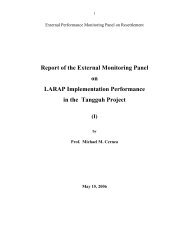
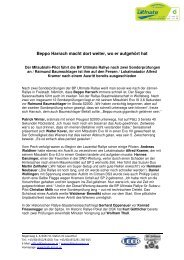
![[PDF] Deepwater Horizon: Accident Investigation Report - BP](https://img.yumpu.com/51697031/1/190x245/pdf-deepwater-horizon-accident-investigation-report-bp.jpg?quality=85)
